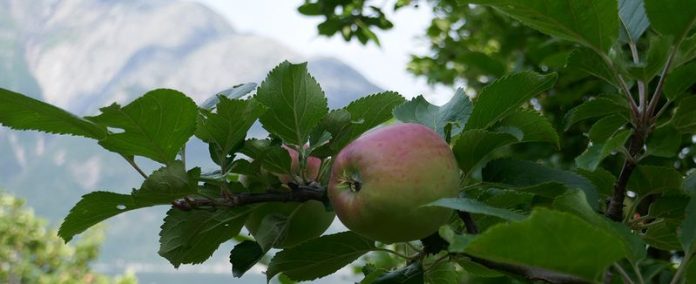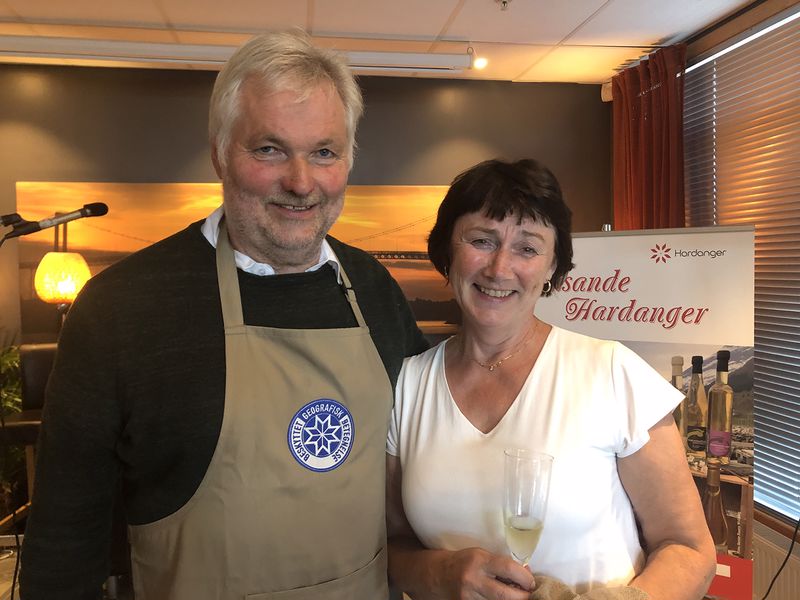
The green apples are about to ripen on the apple trees that stand in neat steep rows almost down to the edge of the fjord. Further up the side of the valley, where the apple trees end, the conifers take over and then the mountains. This is the view from the hybrid boat on the Cider Safari on Hardanger Fjord.
There are now 21 cider farms in Hardanger, and 8–9 of these derive their main income from cider production. In other words, there has been a large increase in both the number of cider producers and cider products over the past decade. The “Cider from Hardanger” brand is strong.
The level of ambition is high among the cider producers, or in the words of Olav Bleie from Alde Sider:
“The goal is that when you hear the word Hardanger, you don’t think first about the prince, the fjord or the mountain, but you think about the cider.

Longing for home
The nature in Hardanger must be among the best nature that Norway has to offer. It means that many people want to return here after their studies or after spending a few years working elsewhere in the country. Building up an expert environment around both apple cultivation and cider production is another important reason why young people are happy to return home. One of them is Eirik Naa Aga.
He produces the cider 57/2 on his farm, Store Naa, in Ullensvang. It is the farm and cadastral numbers that are the source of the name of the renowned cider.
“This is what I would like to invest in as a farmer. Without the opportunity to produce cider as I wish and sell it to a restaurant and especially from a farm, it is doubtful that I would have considered taking over the farm. This gives me a real challenge and I can work with what I am passionate about” says Eirik Naa Aga.
Terroir, or the taste of Hardanger
Nature, or more accurate the soil, terrain and climate, has a lot to do with the taste of the apples and thus the cider. In Hardanger, the climate is mild, spring comes early and the apple trees are usually located on steep sunny slopes, where the soil is good and warm.
The terroir term is used as a collective term for how these nature-given conditions affect taste and other sensory properties. Terroir is mostly used to characterize wine from different districts. But now the term is taking the serious step into the world of Hardanger Cider.
The goal of the Cider Culture project is to find the answer to whether and how the nature-given conditions in Hardanger characterize cider from here. In order to succeed, a close collaboration has already been established between the cluster of cider producers, the Hardanger Council and researchers from Nibio and Nofima.
Characteristics of Cider from Hardanger
Researchers and taste judges at Nofima are at the beginning of the process of developing a taste chart, where the cider varieties in Hardanger will be positioned based on their flavours and aroma.
The work performed on the taste chart has several steps. First, Nofima’s trained taste judges agree on relevant characteristics that describe the ciders. Then they practice calibrating the taste experiences as the judges’ analyses of the various characteristics coincide. The next step is to analyse a selection of cider samples, and to judge the intensity of the relevant characteristics for each sample.
The taste chart will show variations in aroma for Norwegian cider and it will be possible to investigate how cultivation conditions, apple variety, yeast type and processing and production conditions affect the flavour properties.
Nibio’s professionals have started work on characterizing key chemical components, and are in the process of establishing a tasting panel in close cooperation with Nofima. The tasting panel will be led by Marianne Hotle at NIBIO Ullensvang.
NIBIO is also in the process of quality assuring the methods currently used in the analysis laboratory. The goal is to provide analysis services for the assessment of chemical properties in accordance with international standards.
Expertise is needed to develop the district
It is said that apples were first brought to Hardanger by monks about 800 years ago. Cider has been produced on farms here since the 19th century. Cider production has long traditions in Hardanger. It is produced and based on the knowledge and experience that exists locally. This is combined with newly developed insights about sensory and chemical factors, among other things.
In 2009, “Cider from Hardanger” received a protected geographical designation, just like champagne, Parmesan cheese and Tjukkmjølk from Rørosmeieriet. The cider is characterized by a slightly acidic and aromatic apple flavour. Now the producers want to develop both the drink and the districts. Knowledge and research are key factors here. A research and development centre for cider is currently being established at NIBIO Ullensvang. The cider tasting panel will meet here, and a digital knowledge platform will be established.
Facts about the project
The project is called Cider Culture in Norwegian and is called “Uncorking rural heritage”, or “Uncorking wine and cider typicality”. Here, research and new knowledge will contribute to the development and innovation of wine from the Balkans and cider in Hardanger. The project will run from 2020 to 2023 and is funded by Iceland, Liechtenstein and Norway through the EEA and Norway Grants Fund for Regional Cooperation.

